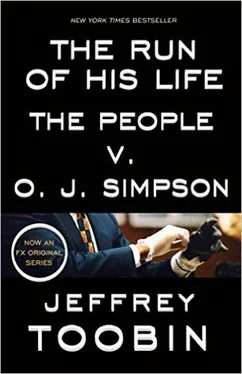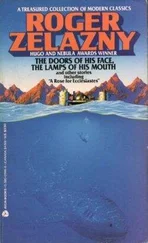Riske led the two detectives through the house, including the second floor, and then back to the landing. There Phillips and Fuhrman could see the two bodies in front and the bloody shoe prints on the walkway leading to the back alley. Riske shined his flashlight around the scene once more, pointing out for the detectives the envelope as well as the hat and the glove, which were partially obscured by the foliage. They went back into the house and left through a door that opened onto the walkway that ran along the northern edge of the property. Riske showed them at close range the bloody shoe prints with the blood drops to the left. The three men then went out the back gate, which was, Riske pointed out, also stained with blood, especially on the handle.
After they completed their tour, Phillips and Fuhrman split up. Phillips stayed outside to use his cellular phone. Fuhrman wanted to make some notes of what he had seen. He wasn’t writing a formal report at this stage, just his preliminary observations to refer to as his investigation proceeded. Fuhrman reentered the house through the garage and sat down on a couch in the living room to scribble down some of what he had seen and been told. Numbering his entries, Fuhrman noted that Riske had discovered the bodies and made the initial report. The causes of death were still unknown, and Fuhrman hadn’t gotten close enough to the bodies to make any definitive finding. The third item in his notes said the victims had “Possible GSW”-gunshot wounds. Fuhrman made reference to the two children who had been taken to the police station, the lit candles, the melting ice cream. Fuhrman noted the blood drops to the left of the shoe prints on the walkway. “Suspect ran through this area,” he wrote. “Suspect possibly bitten by dog.” He made several mentions of blood on the rear gate, including a note that said, referring to the handle that opened the gate from inside the property, “Possible blood smudge and visible fingerprint.” In all, Fuhrman listed seventeen items for follow-up. He was writing his last entry-“Ski mask, one glove by feet of male victim”-when he was interrupted.
Brad Roberts had arrived and was asking for an update. Fuhrman quickly walked his partner to the landing and showed him the bodies, the hat, and the glove, and then they went back along the walkway that was marked with the bloody shoe prints. Afterward, Roberts headed around the block toward the Bundy entrance, and Fuhrman returned to the couch to work on his notes. He was interrupted again. This time it was his boss, Ron Phillips. Phillips told Fuhrman that the West L.A. team was off the case. It was being turned over to Robbery-Homicide Division, the headquarters unit that handles especially complex or high-profile cases. Moments later, Fuhrman followed Phillips out of the house through the garage. It was about 2:40 A.M., and Mark Fuhrman’s tenure as lead detective on this double homicide was over. It had lasted about thirty minutes.

Shortly after arriving at Bundy, Phillips had received a cellular phone call from one of the highest-ranking officers in the entire LAPD. Keith Bushey was the commander of operations for the western quarter of Los Angeles, a region that included not only West L.A. but the Hollywood, Pacific, and Wilshire divisions as well. Bushey had an order for Phillips. Since one of the victims was the ex-wife of O.J. Simpson-and because children presumed to be his had been removed from the house-he wanted Simpson personally informed of the murder. Bushey said he wanted to avoid a “Belushi situation.” (When the actor and comedian John Belushi had died at the Chateau Marmont Hotel in 1982, the news media had learned of it almost instantaneously and broadcast the information before the LAPD had the chance to notify any family members in person. It had been painful for Belushi’s family and embarrassing for the LAPD.)
Phillips hadn’t had a chance to act on this order in his first half hour on the scene because he had, for the most part, been inspecting the evidence with Fuhrman. Then, at about 2:30 A.M., Lieutenant Frank Spangler, in charge of all detectives in West Los Angeles and thus Phillips’s boss, arrived bearing the news that Phillips and his team were to withdraw from the case in deference to the Robbery-Homicide Division. In light of this change, Phillips decided that he would hold off on notifying Simpson as well.
Fuhrman pointed out some of the evidence, including the single glove and the envelope, for a police photographer who had arrived on the scene, but for the most part Fuhrman and Phillips stood around and waited for the detectives who were going to replace them. They stood together on Bundy chatting for almost an hour and a half, although at one point Fuhrman and Spangler did approach the male victim from the adjacent property to the north and together stared at the body through a fence.
At 4:05 A.M., Philip Vannatter, a Robbery-Homicide detective, arrived. Phillips mentioned to Vannatter that Bushey had ordered him to tell O.J. Simpson in person about the deaths. What should he do? Vannatter brushed off the issue, saying he would worry about it after he had seen the crime scene. At that point, Phillips walked Vannatter through the crime scene as he had been introduced to it by Officer Riske. At 4:30, Vannatter’s partner, Tom Lange, arrived, and Phillips gave him the tour, too. The LAPD had about fourteen hundred detectives, and neither Phillips nor Fuhrman had ever previously met Vannatter or Lange.
When the two senior detectives had completed their walkthroughs, Phillips again raised the issue of Bushey’s order for an in-person notification of Simpson. He was concerned about not having followed a very specific order from a high-ranking official. When was O.J. going to be notified? Vannatter said that since it was Simpson’s ex-wife who had been murdered, he and Lange would need to interview him anyway. As Lange testified later, “I think it is very important to establish a rapport, especially with persons who are close to the victim, to get information.” And besides, Simpson might be able to help them identify the male victim, whose name the police did not yet know. There was also the matter of the children. Simpson, who was bound to be upset at the news of the murder, might well need some assistance in collecting the boy and girl from the police station. So Vannatter decided that all four detectives would make the trip to Simpson’s home. Vannatter and Lange would introduce themselves to Simpson, assist in the notification, and then return promptly to begin their investigation of the crime scene, while the two junior detectives would help Simpson retrieve his children. Before they left, they had to settle one obvious question: Where did Simpson live?
Fuhrman said he knew. He told Phillips that when he was a uniformed patrol officer in West L.A., he had gone on a radio call to the Simpson home. “I went up there a long time ago on a family dispute,” Fuhrman said. “I think I can find it.” He didn’t remember the exact address, but Riske, who had run the plates on the Jeep parked in Nicole’s garage, told Fuhrman that the plates had come back to 360 North Rockingham. In his report of the evening’s activities, Lange summarized Fuhrman’s information this way: “Mr. Simpson and victim had been embroiled in previous domestic-violence situations, one of these resulting in the arrest of Mr. Simpson.” (Phillips later testified he did not remember any such discussion that evening, although it is possible he simply did not hear what Fuhrman said to Lange.) So, at just about 5:00 A.M., Phillips and Fuhrman led Vannatter and Lange in a two-car caravan from Bundy to Rockingham. The two-mile trip took about five minutes.
As the two cars made a right turn off Sunset Boulevard onto Rockingham Avenue, the terrain changed and the houses grew larger, grander. Traveling uphill along the silent street, the detectives strained to see the house numbers painted on the curbs. Earlier in his career, Vannatter had spent four years as a detective in West L.A., yet he had never driven on or even heard of Rockingham. It was not the kind of street that generated much police activity. Still, on that night he noticed one of the customs of the neighborhood. Rockingham was not a major artery, but it did serve as the conduit to Sunset for many smaller streets, and residents tended to avoid parking on it so that traffic could move freely. On this night, Rockingham was empty-except for a single vehicle. Just before the detectives reached the intersection of Rockingham Avenue and Ashford Street, Vannatter noticed a white Ford Bronco by the curb. On closer inspection, it appeared that the vehicle was slightly askew, as if it had been hurriedly parked. As it turned out, this car was stopped directly in front of number 360, which occupied the corner lot. The detectives turned right onto Ashford and parked their two cars near an iron gate set in the brick wall that surrounded O.J. Simpson’s property.
Читать дальше













